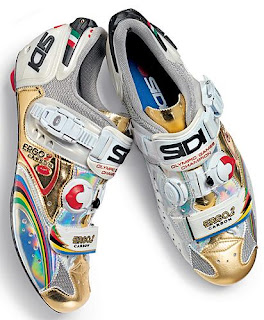There are a few prime spots every rider needs to pay particular attention to: hands, groin, and feet. What do these have in common? Weight-bearing contact points on your bike. Today we’re focusing on the feet and the early learning purchasing decisions associated with cycling shoes, specifically, sole materials. Do you (or should you) skip right over the cheaper carbon composites and invest the $50-$250 more for full carbon soles?
Let’s get two things out of the way: First, you’ve invested thousands of dollars into a bicycle, it is pretty much blasphemy to put flat pedals or mountain bike pedals on your steed. Second, for the purpose of this article, I will be using the term “clipped inâ€, even though cleat systems that lock into pedals are “clipless pedals†and old school pedals that have leather straps on the pedals are “toe clipsâ€.
Why cycling shoes? Well, cycling shoes “lock†your feet into the pedal, essentially, making you one with your bicycle. This allows for maximum control of your bicycle, [hopefully a] more efficient pedal stroke, and maximum potential power transfer. Anyone who has ever tried to ride up a steep hill or go all out in a sprint without being clipped into your pedals will tell you the difference. The loss of power, speed, and security is profuse.
The typical characteristics of well-developed cycling shoes are comfort, light weight, maximal power transfer, and durability. Cycling shoes are not made for walking. Personally, I ride Shimano SPD-SLs pedals/cleats (both road and triathlon), but never really have trouble walking in my shoes. When I do my triathlons, I can “run†in them just fine out of T1 (FYI, I’m faster than quite a few people who leave their shoes clipped in).
One of my peers who works in the bicycle retail shop and is extremely helpful with shoe sales tells me that customers getting into the sport are often dealing with a lot of unknowns and a budget. The new riders are spending thousands of dollars on a bike, gear, helmet, and clothing. Thus, the idea of spending $160+ on shoes can be frustrating. However, cycling shoes last a lot longer and you get what you pay for. Not to go on a tangent, but here is my shoe history: I’ve had my mountain bike shoes ($180) for thirteen years (they don’t smell, I swear), my first pair of road shoes for six years ($250) (they started to smell), and my most recent pair of road shoes ($350) are going on three years. So, I’ve been getting my money’s worth.
Now, back to my peer’s insight and what she has seen over the years. She always asks what a rider’s goals are for riding and then goes from there. For riders that typically do sub-twenty-five mile rides (under 1.5 hrs), the shoe sole flex is not that big of a deal. These riders are typically more leisure oriented and enjoy exploring the open road on their bikes with the added benefit of being clipped into their pedals. Plus, they have nothing to compare the soles to. However, once these same types of riders start ramping up their mileage, hot spots and issues with foot numbness can begin to creep in because of the composite material’s proclivity to flex during longer rides.
As a result, she says most of these riders upgrade their shoes. Look at it this way, trying to hit a 95mph baseball with a flexy bat wouldn’t fare well because so much power and energy is lost.
For racers and riders that like to mash their pedals, full carbon soles are pretty much a requirement. Every bit of flex in the sole means a potential loss of those precious watts. Ask any sprinter or climber and they abhor flex in their soles.
Buying Criteria for Road Bike Shoes:
Quality: The sub-categories for quality are fit, rigidity, lightness, and construction excellence.
Compatibility: Always make sure your shoes are compatible with your cleat system.
Use: If you are a pure roadie with no need to really worrying about walking (unless it’s into the local coffee house / middle-of-nowhere convenience store), you’re open to whatever cleat system you want. If you’re a triathlete who does not leave their shoes clipped in for T1, then certain pedals are better to “run†in (i.e. Shimano, Look). From reading reviews, forums, and talking to riders, Speedplays are more finicky when it comes to mud, dirt, grass, etc. I have no experience with Time.
Quick Note on Cost:
Bike shoes are just like dress shoes. You can spend a fortune on them, but if you take care of them and treat them well, they will last a long time. I will say, I had a hard time initially justifying spending $350 on my bike shoes, but I realized how much time I spend in them and the craftsmanship and it makes the “buyer’s remorse†go away. But, unless I become sponsored by a shoe company, $350 is my max.
My Personal Buying Criteria:
Super stiff, carbon fiber, solid reviews from online publications/magazines, lightness plays a decent role (but I am not a weight weenie on my shoes), aesthetics (I ride Shimano R 300 and some people hated!!),
Instead of reinventing the wheel, I did find an article that gives a concise and straight-forward description of some design features required in cycling shoes. The below excerpt is taken from http://www.bicycleapparel.com/shoes.html.
LOWER END CYCLING SHOES The Sole of the Shoes
The material used in the sole of the shoe is a reflection of the quality of the shoe. Most lower end cycling shoes have an injection-molded plastic sole. Injection-molded plastic soles are more economical to produce, but are heavier, and not as stiff as the carbon fiber or fiberglass that is used in higher end shoes. As such, they are more flexible.Remember: The stiffer the sole of your shoe, the more stable the platform to transmit power.
MID- RANGE CYCLING SHOES
The material used in most mid-range cycling shoes is a combination of plastic and carbon fibre, plastic and fiberglass, or an all carbon fiber sole. Adding carbon fiber, or fiberglass to a shoe is more expensive, but is makes the sole stiffer and lighter weight.HIGH END CYCLING SHOES
All high-end competition level shoes use carbon fiber soles. Carbon fiber is lightweight and very stiff, providing a stable platform.Materials in the Upper Part of the Shoe
Soft supple materials such as leather provide greater comfort and fewer breaks in time. Higher end shoes usually have a real leather upper, while lower end shoes have synthetic leather, or plastic uppers.
All in all, unless you know beyond a reasonable doubt you will never do long rides, or mash the pedals in a sprint, and just want to tour around, you can be satisfied with a carbon composite sole. Do not read me wrong here, a lot of companies make some fantastic less expensive shoes, but when performance matters most, and some fantastic shoes are only $50-$100 more for carbon fiber soles, go carbon fiber.
[Update 2-27-2012]
Blurb from Bicycling Magazine:
[quote]Inexpensive shoes disappoint, with poor closure systems that won’t cinch your feet comfortably, and flimsy uppers that wear quickly. Quality footwear includes features such as racheting buckles and stiff carbon soles. Spend what it takes to find the proverbial shoe that fits, and don’t order online just to save $5. Buy from a shop so you can try multiple models and sizes. [/quote]
What are your thoughts? Where do you draw the line for cost? Do you ride carbon composites and crank out the miles? How long do you keep your shoes? And, yes, I realize my title references whiskey, but the image is a vodka-based martini.
Zane


